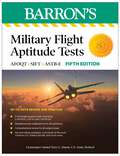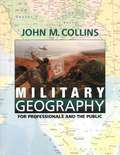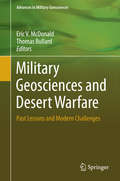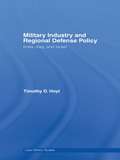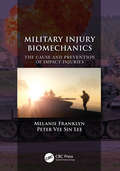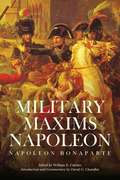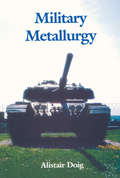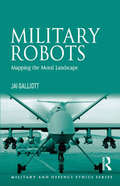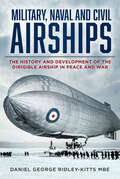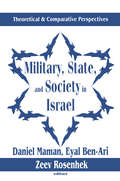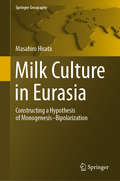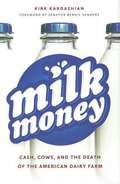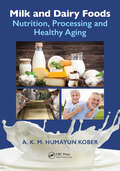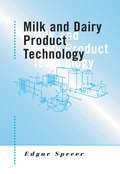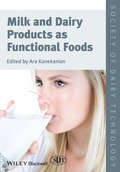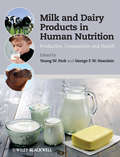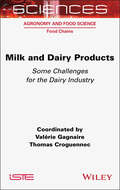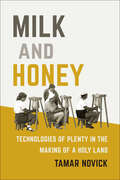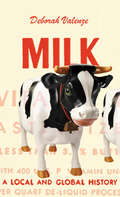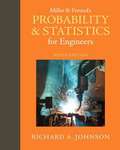- Table View
- List View
Military Flight Aptitude Tests, Fifth Edition: 6 Practice Tests + Comprehensive Review (Barron's Test Prep)
by Terry L. DuranBe prepared for exam day with Barron&’s. Trusted content from Military Flight Aptitude Test experts!Barron&’s Military Flight Aptitude Tests includes in-depth content review and practice. It&’s the only book you&’ll need to be prepared for exam day.Written by Experienced EducatorsLearn from Barron&’s--all content is written and reviewed by Military Flight Aptitude Test expertsBuild your understanding with comprehensive review tailored to the most recent exams:AFOQT (Air Force Officer Qualifying Test)SIFT (Army Selection Instrument for Flight Training)ASTB-E (Navy/Marine Corps/Coast Guard Aviation Selection Test Battery)Get a leg up with tips, strategies, and study advice for exam day--it&’s like having a trusted tutor by your sideBe Confident on Exam DaySharpen your test-taking skills with 6 practice tests, including 2 practice AFOQTs, 2 practice SIFTs, and 2 practice ASTB-EsReinforce your learning with detailed answers and explanations for all test questionsStrengthen your knowledge with in-depth review covering all major subtests and topics covered on each exam, including language, mathematics, technical knowledge, science, and mental skillsDeepen your understanding with expert advice about becoming an officer and aviator, detailed summaries of common aircraft used by the U.S. military today, a glossary of key terms and definitions, and much more
Military Geography: For Professionals and The Public
by John M. CollinsThis book covers many topics that are crucial to military planning but often receive only passing mention in histories or briefings. Collins, a former Army officer, stresses land geography, but he does not stint oceans, the atmosphere, or interplanetary space. His discussions of urban areas are too brief, given the increasing amount of large-scale violence in cities since the end of World War II.
Military Geosciences and Desert Warfare
by Eric V. Mcdonald Thomas BullardThis book is a collection of papers presented at the 9th International Conference of Military Geoscience that was held in 2011. The conference included discussion on a diverse range of geosciences, including military history, military geology, teaching geology from a military prospective, geological influence on the battlefield, and environmental and cultural issues related to management of military lands. Geology and geography have played a significant role in military history, from providing the stone for primitive tools and weapons, to the utilization of terrain in offensive and defensive strategies. Specific to this volume, deserts comprise nearly a third of the Earth's surface and have been the site of numerous battles where the dust, heat, and a lack of food and water have provided challenges to military leaders and warriors. This book examines the role of deserts in past and modern warfare, the problems and challenges in managing military lands in desert regions, and how desert environmental conditions can impact military equipment and personnel. This proceedings volume should be of interest to scholars, professionals, and those interested in military history, warfare, geology, geography, cultural resources, general science, and military operations.
Military Industry and Regional Defense Policy: India, Iraq and Israel (Cass Military Studies)
by Timothy D. HoytMilitary Industry and Regional Defense Policy re-examines military industrialization in the developing world, focusing on policy-making in producer states and the impact of security perceptions on such policy-making. Timothy D. Hoyt reassesses the role of regional state sub-systems in international relations, and recent historical studies of international technology and arms transfers. Looking at Israel, Iraq and India, the three most powerful regional powers in the Cold War era, he presesnts an expert analysis of the three-sided phenomena of the regional hegemony, the regional competitor and the small over-achiever. This new book breaks away from existing literature on military industries in the developing world, which has focused on their economic and development costs and benefits. These past studies have used primitive methodologies that focus on the production of complete weapons systems - a misleading gauge in a world of growing international defense cooperation. They have also ignored empirical evidence of the impact of local military industrial production on Cold War regional conflict, and of the defence planning and concerns that drove development of indigenous military industries in key regional powers. This new text delivers an incisive new perspective.
Military Injury Biomechanics: The Cause and Prevention of Impact Injuries
by Melanie Franklyn Peter Vee LeeMilitary Injury Biomechanics: The Cause and Prevention of Impact Injuries is a reference manual where information and data from a large number of sources, focussing on injuries related to military events, has been critically reviewed and discussed. The book covers the cause and prevention of impact injuries to all the major body regions, while topics such as the historical background of military impact biomechanics, the history and use of anthropomorphic test devices for military applications and the medical management of injuries are also discussed. An international team of experts have been brought together to examine and review the topics. The book is intended for researchers, postgraduate students and others working or studying defence and impact injuries.
Military Innovation in The Interwar Period
by Williamson Murray Allan R. MillettIn 1914, the armies and navies that faced each other were alike right down to the strengths of their companies and battalions and the designs of their battleships and cruisers. Differences were of degree rather than essence. During the interwar period, however, the armed forces grew increasingly asymmetrical, developing different approaches to the same problems. This 1996 study of major military innovations in the 1920s and 1930s explores differences in exploitation by the seven major military powers. The comparative essays investigate how and why innovation occurred or did not occur, and explain much of the strategic and operative performance of the Axis and Allies in World War II. The essays focus on several instances of how military services developed new technology and weapons and incorporated them into their doctrine, organisation and styles of operations.
Military Intelligence Blunders and Cover-Ups: New Revised Edition
by Colonel John Hughes-WilsonThis book is a professional military-intelligence officer's and a controversial insider's view of some of the greatest intelligence blunders of recent history. It includes the serious developments in government misuse of intelligence in the recent war with Iraq. Colonel John Hughes-Wilson analyses not just the events that conspire to cause disaster, but why crucial intelligence is so often ignored, misunderstood or spun by politicians and seasoned generals alike. This book analyses: how Hitler's intelligence staff misled him in a bid to outfox their Nazi Party rivals; the bureaucratic bungling behind Pearl Harbor; how in-fighting within American intelligence ensured they were taken off guard by the Viet Cong's 1968 Tet Offensive; how over confidence, political interference and deception facilitated Egypt and Syria's 1973 surprise attack on Israel; why a handful of marines and a London taxicab were all Britain had to defend the Falklands; the mistaken intelligence that allowed Saddam Hussein to remain in power until the second Iraq War of 2003; the truth behind the US failure to run a terrorist warning system before the 9/11 WTC bombing; and how governments are increasingly pressurising intelligence agencies to 'spin' the party-political line.
Military Intelligence Blunders and Cover-Ups: New Revised Edition
by John Hughes-WilsonThis book is a professional military-intelligence officer's and a controversial insider's view of some of the greatest intelligence blunders of recent history. It includes the serious developments in government misuse of intelligence in the recent war with Iraq. Colonel John Hughes-Wilson analyses not just the events that conspire to cause disaster, but why crucial intelligence is so often ignored, misunderstood or spun by politicians and seasoned generals alike. This book analyses: how Hitler's intelligence staff misled him in a bid to outfox their Nazi Party rivals; the bureaucratic bungling behind Pearl Harbor; how in-fighting within American intelligence ensured they were taken off guard by the Viet Cong's 1968 Tet Offensive; how over confidence, political interference and deception facilitated Egypt and Syria's 1973 surprise attack on Israel; why a handful of marines and a London taxicab were all Britain had to defend the Falklands; the mistaken intelligence that allowed Saddam Hussein to remain in power until the second Iraq War of 2003; the truth behind the US failure to run a terrorist warning system before the 9/11 WTC bombing; and how governments are increasingly pressurising intelligence agencies to 'spin' the party-political line.
Military Maxims of Napoleon
by Napoleon Bonaparte David G. Chandler Daniel Chandler William E. CairnesAn essential volume of Napoleon’s wisdom on the art of war. Nearly two hundred years after his death, Napoleon remains widely regarded as one of the greatest military commanders of all time. Here, in one volume, is the essence of Napoleon’s knowledge and wisdom, the fruit of his practical experience, and his study of the great empire-builders from Alexander to Frederick the Great. Working from the best among previous editions of Napoleon’s maxims, including the work produced in 1901 by William E. Cairnes, noted Napoleonic historian David G. Chandler has contributed commentary that examines Napoleon’s work from the twentieth-century perspective of the two world wars, Vietnam, and other conflicts, and analyzes the ways in which commanders have observed or failed to observe Napoleon’s teachings. The Military Maxims of Napoleon is a unique collection of tenets on the art of war. They reveal the principles on which his military, diplomatic, and political triumphs were built. Now every military student and enthusiast can benefit from the brilliance of Napoleonic insight and wisdom. "The Military Maxims of Napoleon provides a most valuable insight into the Napoleonic art of war . . . David G. Chandler is the foremost modern authority on the subject, which makes this work essential reading. ” --Philip J. Haythornthwaite, author of Invincible Generals Skyhorse Publishing, as well as our Arcade imprint, are proud to publish a broad range of books for readers interested in history--books about World War II, the Third Reich, Hitler and his henchmen, the JFK assassination, conspiracies, the American Civil War, the American Revolution, gladiators, Vikings, ancient Rome, medieval times, the old West, and much more. While not every title we publish becomes a New York Times bestseller or a national bestseller, we are committed to books on subjects that are sometimes overlooked and to authors whose work might not otherwise find a home.
Military Metallurgy
by Alistair DoigThis book gives a broad based view of metals in military service, covering several examples and rationales. It is useful for the militarist and for the metallurgist or materials scientist. The content of the book is based on course notes compiled for undergraduate and post-graduate students.
Military Robots: Mapping the Moral Landscape (Military and Defence Ethics)
by Jai GalliottPhilosophers have wrestled over the morality and ethics of war for nearly as long as human beings have been waging it. The death and destruction that unmanned warfare entails magnifies the moral and ethical challenges we face in conventional warfare and everyday society. Intrinsically linked are questions and perennial problems concerning what justifies the initial resort to war, who may be legitimately targeted in warfare, who should be permitted to serve the military, the collateral effects of military weaponry and the methods of determining and dealing with violations of the laws of war. This book provides a comprehensive and unifying analysis of the moral, political and social questions concerning the rise of drone warfare.
Military, Naval and Civil Airships Since 1783: The History and Development of the Dirigible Airship in Peace and War
by Daniel G. Ridley-KittsExploring the history and development of the dirigible airship from its humble beginnings in the late eighteenth century, through to its current role as military command posts among other uses, this book is a comprehensive account of the dirigible airship.Starting out as an unreliable experimental aircraft as aeronauts first began to learn the secrets of aerial navigation, the airship was then remodelled in 1900 by Count Zeppelin to become a potent weapon of war then transformed again into a short-lived solution to long-distance passenger air travel. With over 100 technical drawings and contemporary images of dirigible aircraft, Ridley-Kitts here presents a comprehensive and fascinating history of the airship – a must read for those that wish the delve into the development of the aircraft for the first time and for airship specialists alike.
Military, State, and Society in Israel: Theoretical and Comparative Perspectives
by Daniel MamanThere have been many books on the place of war, security, or military service in Israeli society. The Military, State, and Society in Israel makes contributions to the debate-theoretical, empirical, and polemical-that are related to the Israeli case and to wider debates about the place of war and the military in contemporary industrialized societies. The Israeli case is important in the development of more macro approaches to the study of "things military" as war has played a central role in Israel's history and continues to do so. The book encapsulates in a very explicit manner tensions in the relationships between the military, state, and society and stands at the core of contemporary debates between two fundamental approaches to the study of the relations between the military society and the state: the "armed forces and society" school and the "state-making and war" perspective.Contemporary Israel is the site of debates about many of the fundamental assumptions that have undergirded the Jewish nation-state: the ethnic character of nationhood and statehood; the role of the Jewish diaspora vis-Ó-vis Israel; the legitimacy of Jewish "ethnic pluralism"; the meaning of the Holocaust; privatization of social life and the spread of consumerism; and weakening of the centralized state as the agent of social transformation affecting housing, language, health, technology, production, dress, and child-rearing. One important consequence of these internal conflicts and struggles has been a significant erosion in the almost sacred status once enjoyed by state institutions, and especially the military, among the majority of Jewish population."Theoretical and Comparative Perspectives," situates Israel in its wider theoretical and comparative context and shows how the study of Israel contributes to the theoretical understanding of contemporary changes in civil-military relations. "The Politics of Civil-Military Relations," concentrates on current changes in Israeli politics, the character of the conflict with the Palestinians, and the place of military in society. "The State and War-Making-Creating Citizens, Soldiers, and Men and Women," indicates how war and the military are not only instruments for state-making, but are also important factors in the formation of individual identities. "The Notion of 'National Security'-Institutions and Concepts," raises the basic question of whether the institutional mechanisms and the strategic conceptions crystallized during the first 50 years of Israel's existence are still relevant in a changing post-cold war world. "The Armed Forces as Organization, Continuity and Change," focuses on the lines of continuity and trends of change in several aspects of the Israeli Defense Forces' internal organizational structure.Studies based on Israeli cases, data, and scholarship have been central to the development of expertise in such fields as applied psychology and psychotherapy. This volume contributes to these areas of study, and will be of central importance to professionals interested in civil-military.
Milk Culture in Eurasia: Constructing a Hypothesis of Monogenesis–Bipolarization (Springer Geography)
by Masahiro HirataThe invention of milking and milk use created a new mode of subsistence called pastoralism. On rangelands across Eurasia, pastoralists subsist by extensive animal husbandry and by processing their animals’ milk. Based on the author’s fieldwork over more than two decades, this book details the processing systems and uses of milk observed in pastoralist and farm households in West Asia, South Asia, North Asia, Central Asia, the Tibetan Plateau, and Europe and the Caucasus. Milk culture in each region is characterized by its processing technology and use of milk, and characteristics common to wider geographical spheres are identified. Inclusion of case studies from the literature expands the continent-wide perspective and provides further indications of how milk culture developed and diffused historically. The inferences drawn are expressed in the author’s monogenesis–bipolarization hypothesis of Eurasian milk culture, that milking and milk processing had a single center of origin in West Asia, and that the technology involved the spread from there across the continent, developing distinct characteristics in northern and southern spheres. Finally, because milk culture underpins pastoralism as a mode of subsistence, the typology and theory of pastoralism are re-examined from the standpoint of milk culture.
Milk Money: Cash, Cows, and the Death of the American Dairy Farm
by Kirk KardashianThe book speaks about the failing economics of the traditional small dairy farm, the rise of the factory mega-farm with its resultant pollution and disease, and the uncertain future of milk.
Milk Production Management
by Prafullakumar V. Patil Matsyagandha K. PatilMilk Production Management, as the name implies, provides the information on different aspects related to Milk Production Management. The information in this book will be of practical utility for actual feeding of animals e.g. chapters on various rations, nutrient requirement tables, feeding of pregnant/lactating animals, feeding of calves, silage making, hydroponics technique, azolla production different feeds and fodders, fodder cultivation, computation of rations for dairy animals, feeding during scarcity periods etc. In this book different topics like common disease problems of dairy animals and their prevention and control, methods of selection, different breeding systems, semen collection and artificial insemination, different biotechniques used in animal husbandry, milking methods, embryo transfer technique, judging of cows and buffaloes, milk synthesis and milk secretion, record keeping at dairy farms, reproductive aspects of dairy animals etc. are also covered.The book also covers different terms related to animal husbandry. This book is written in simple understandable language with description of those concepts which are useful for actual management of animals. Note: T&F does not sell or distribute the Hardback in India, Pakistan, Nepal, Bhutan, Bangladesh and Sri Lanka.
Milk and Dairy Foods: Nutrition, Processing and Healthy Aging
by A. K. KoberMilk and Dairy Foods: Nutirtion, Processing and Healthy Aging focuses on updated knowledge about the effect of milk and dairy foods on healthy aging. It outlines the nutritional and health benefits of milk and major dairy foods. This book also covers the milk processing and manufacturing process of value-added dairy foods such as yogurt, cheese, cream, butter, ghee, powdered milk, condensed milk, ice cream, and traditional dairy foods.The text discusses the global milk and dairy-food production trends, opportunities, and challenges along with the chemistry and microbiology of milk. The book also includes in-depth discussions of the immunomodulation potential of dairy foods particularly probiotics fermented dairy foods.Key Features Emphasizes that eating whole and low-fat dairy products is not linked to an increased risk of cardiovascular diseases Focuses the processing techniques of high-quality value-added products Covers various kinds of dairy foods, their production, nutritive values, and health attributes Includes quality control and the chemotherapeutic value of different dairy foods including South Asian traditional dairy foods Reviews a range of dairy foods such as yogurt, cheese, cream, butter, ghee, powdered milk, condensed milk, ice cream, and traditional dairy foods Discusses dairy food innovations from production to nutritional and health attributes Illustrates more than 200 key concepts Highlights the role of the dairying in supporting the achievement of the UN sustainable development goals Each chapter includes learning objectives as well as a bubble box for the convenience of readers Each chapter contains value-added dairy items/issues with the latest information that is crucial for students, professionals, and readers This book is meant for undergraduate and postgraduate students in food science, dairy science, nutrition, microbiology, medical, veterinary, biotechnology & allied disciplines, and those involved in formulating and producing dairy foods.
Milk and Dairy Product Technology (Food Science And Technology Ser. #83)
by Edgar SpreerAddressing both theoretical and practical issues in dairy technology, this work offers coverage of the basic knowledge and scientific advances in the production of milk and milk-based products. It examines energy supply and electricity refrigeration, water and waste-water treatment, cleaning and disinfection, hygiene, and occupational safety in dairies.
Milk and Dairy Products as Functional Foods (Society of Dairy Technology)
by Ara KanekanianThere continues to be strong interest within the food industry in developing new products which offer functional health benefits to the consumer. The premium prices that can be charged make these added-value products lucrative for manufacturers, and they are also commercially popular. Dairy foods are central to this sector: they are good delivery systems for functional foods (yoghurts, milk drinks, spreads) and are also rich in compounds which can be extracted and used as functional ingredients in other food types. Milk and Dairy Products as Functional Foods draws together a wealth of information regarding the functional health benefits of milk and dairy products. It examines the physiological role and the claimed health effects of dairy constituents such as proteins, bioactive peptides, conjugated linoleic acid (CLA), omega 3 fatty acids vitamin D and calcium. These constituents have been shown to be, for example, anticarcinogenic, anti-inflammatory, antihypertensive, hypocholesterolemic, immune-modulating and antimicrobial. This book examines the evidence for these claims, and investigates practical approaches for utilising these attributes. The book is aimed at dairy scientists and technologists in industry and academia, general food scientists and technologists, microbiologists and nutritionists together with all those involved in the formulation and production of functional food products.
Milk and Dairy Products in Human Nutrition: Production, Composition and Health
by Young W. Park George F.W. HaenleinMilk is nature’s most complete food, and dairy products are considered to be the most nutritious foods of all. The traditional view of the role of milk has been greatly expanded in recent years beyond the horizon of nutritional subsistence of infants: it is now recognized to be more than a source of nutrients for the healthy growth of children and nourishment of adult humans. Alongside its major proteins (casein and whey), milk contains biologically active compounds, which have important physiological and biochemical functions and significant impacts upon human metabolism, nutrition and health. Many of these compounds have been proven to have beneficial effects on human nutrition and health. This comprehensive reference is the first to address such a wide range of topics related to milk production and human health, including: mammary secretion, production, sanitation, quality standards and chemistry, as well as nutrition, milk allergies, lactose intolerance, and the bioactive and therapeutic compounds found in milk. In addition to cow’s milk, the book also covers the milk of non-bovine dairy species which is of economic importance around the world. The Editors have assembled a team of internationally renowned experts to contribute to this exhaustive volume which will be essential reading for dairy scientists, nutritionists, food scientists, allergy specialists and health professionals.
Milk and Dairy Products: Some Challenges for the Dairy Industry (ISTE Consignment)
by Thomas Croguennec Valérie GagnaireMilk is considered a complete food, consumed at all stages of life. It is transformed into numerous products, fermented or not, as well as into a variety of ingredients, in order to preserve it or some of its constituents from a few days to a few years. This book addresses the innovations that deal with milk and the use of gentle techniques that best preserve dairy constituents. This book explores some of the current challenges facing the milk processing industry, namely: i) showing the advances in infant milk formula to best mimic breastfeeding and the in vitro models that study newborn digestion, ii) combining tradition and new consumer expectations on emblematic dairy products, such as yogurt and fermented milk products, iii) defining optimal cheese-making practices to control both cheese quality and yield, iv) outlining the current research approaches to meet “consum’actor” demands, as well as those dealing with v) the fouling and cleaning of dairy equipment in a context of increasingly constrained water and energy use.
Milk and Honey: Technologies of Plenty in the Making of a Holy Land
by Tamar NovickAn innovative historical analysis of the intersection of religion and technology in making the modern state, focusing on bodily production and reproduction across the human-animal divide.In Milk and Honey, Tamar Novick writes a revolutionary environmental history of the state that centers on the intersection of technology and religion in modern Israel/Palestine. Focusing on animals and the management of their production and reproduction across three political regimes—the late-Ottoman rule, British rule, and the early Israeli state—Novick draws attention to the ways in which settlers and state experts used agricultural technology to recreate a biblical idea of past plenitude, literally a &“land flowing with milk and honey,&” through the bodies of animals and people. Novick presents a series of case studies involving the management of water buffalo, bees, goats, sheep, cows, and peoplein Palestine/Israel. She traces the intimate forms of knowledge and bodily labor—production and reproduction—in which this process took place, and the intertwining of bodily, political, and environmental realms in the transformation of Palestine/Israel. Her wide-ranging approach shows technology never replaced religion as a colonial device. Rather, it merged with settler-colonial aspirations to salvage the land, bolstering the effort to seize control over territory and people.Fusing technology, religious fervor, bodily labor, and political ecology, Milk and Honey provides a novel account of the practices that defined and continue to shape settler-colonialism in the Palestine/Israel, revealing the ongoing entanglement of technoscience and religion in our time.
Milk: A Local and Global History
by Deborah ValenzeThe illuminating history of milk, from ancient myth to modern grocery store.How did an animal product that spoils easily, carries disease, and causes digestive trouble for many of its consumers become a near-universal symbol of modern nutrition? In the first cultural history of milk, historian Deborah Valenze traces the rituals and beliefs that have governed milk production and consumption since its use in the earliest societies.Covering the long span of human history, Milk reveals how developments in technology, public health, and nutritional science made this once-rare elixir a modern-day staple. The book looks at the religious meanings of milk, along with its association with pastoral life, which made it an object of mystery and suspicion during medieval times and the Renaissance. As early modern societies refined agricultural techniques, cow's milk became crucial to improving diets and economies, launching milk production and consumption into a more modern phase. Yet as business and science transformed the product in the nineteenth and twentieth centuries, commercial milk became not only a common and widely available commodity but also a source of uncertainty when used in place of human breast milk for infant feeding. Valenze also examines the dairy culture of the developing world, looking at the example of India, currently the world's largest milk producer.Ultimately, milk&’s surprising history teaches us how to think about our relationship to food in the present, as well as in the past. It reveals that although milk is a product of nature, it has always been an artifact of culture.
Miller & Freund's Probability and Statistics for Engineers
by Richard A. JohnsonThis book introduces probability and statistics to students of engineering and the physical sciences. It is primarily applications focused but it contains optional enrichment material. Miller & Freund's Probability and Statistics for Engineers is rich in exercises and examples, and explores both elementary probability and basic statistics, with an emphasis on engineering and science applications. The text emphasizes designed experiments, especially two-level factorial design. The Ninth Edition includes several new datasets and examples showing application of statistics in scientific investigations, familiarizing students with the latest methods, and readying them to become real-world engineers and scientists.
Millet Rhizosphere (Rhizosphere Biology)
by Anil Kumar Sharma Ramesh Namdeo Pudake Maya Kumari Deepak Rameshwar SapkalThis edited volume is the first book that explicitly explains the link between the extraordinarily small-scale microbial processes and the growth and yield attributes of millet crops. This book includes chapters emphasizing on the effects of rhizosphere biology on long-term millet crop management. Millets are a collection of small-grained cereal grasses that are grown for human carbohydrate needs. They are among the oldest crops, mainly divided into two groups: major and small millets based on seed size. Major millets are composed of sorghum (Sorghum bicolor) and pearl millet (Pennisetum glaucum); while small millets are composed of six species that includes finger millet (Eleusine coracana (L.)), little millet (Panicum sumatrense), kodo millet (Paspalum scrobiculatum (L.)), foxtail millet (Setaria italica (L.)), barnyard millet (Echinochloa frumentacea (L.)), and proso millet (Panicum miliaceum (L.). These crops are earlier considered as orphan crops, but recently due to their nutritional values it is gaining the importance. Various reports are published based on role of rhizosphere on growth and health of these crops. The rhizosphere being a dynamic interface among the plant roots and soil microbes provides a number of advantages to the millets too. The soil properties in rhizospheric region are also different as compared to the bulk soil. This book discovers the functional attributes of rhizosphere in promoting the healthy growth of millet crop and achieving higher yield during the changing climatic condition. This book is of interest to university teachers, scientists working in the millets, and policymakers in agricultural departments. Also, the book serves as additional reading material for undergraduate and graduate students of agriculture, biotechnology, microbiology, genetics, and soil science.
